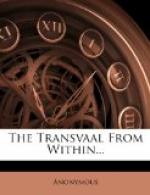{25} In the course of the Inquiry at Westminster, Dr. Jameson himself took occasion to explain this reference, when answering a question put by Mr. Sidney Buxton.
Knowing what you do now of the position at Johannesburg, do you think it was within their power to send out 300 mounted men?—I cannot give an opinion upon that; I think all their actions were perfectly bona fide. There is one telegram here which has been brought up against me very unpleasantly, which I wish I had never sent, where ‘fear’ is imputed in the telegram as it stands here. My explanation is that I was irritated at the time at the trouble going on, and that I used it inadvertently, or possibly there is a mistake in deciphering the code word; as to that I cannot tell, but I am sorry that it should appear so in the telegram, because I never imputed fear or cowardice to anyone in connection with anything.
{26} July 1899. The originals have since been photographed and are here reproduced.
{27} Colonel Francis Rhodes.
{28} Lionel Phillips.
{29} (July, 1899.) Is it not probable that the deleted figures ‘2,000’ in Colonel Rhodes’ letter (see photograph) may account for some of the talk about 2,000 armed men?
{30} After the arrival in England of the officers of Dr. Jameson’s force, a report dealing with the military aspect of the expedition was sent by Sir John Willoughby to the War Office. It has been printed and—to a certain extent—circulated, and cannot therefore be regarded as private. But apart from this it is a document so peculiar—so marked by mishandling of notorious facts—that it deserves no consideration other than it may earn on merits. It is printed in extenso with notes by a member of the Reform Committee. See Appendix H.
{31} See Appendix G. It will be noted that in his declarations Commandant Cronje modifies his terms very considerably. It was impossible for any reasonable person to accept the explanation preferred by him, that the promise to spare the lives of the surrendered force was only to hold good until they could be handed over to the Commandant-General. In fact, it is well known that Commandant Cronje only took up this attitude after an extremely acrimonious discussion had taken place between him and Commandant Malan—a quarrel in which they went the length of making charges against each other in the public press of treachery and neglect of duty whilst in the field. The Commandant Cronje referred to here is the same gentleman who commanded the Boer forces at Potchefstroom in the War of Independence, and his record is an extremely unpleasant one, his conduct of operations having earned for the Potchefstroom commando the worst reputation of any. Apart from the execution of several British subjects who were suspected and, on wholly insufficient grounds, summarily shot as spies, there are the unpleasant facts that he caused prisoners of war to be placed in the forefront




